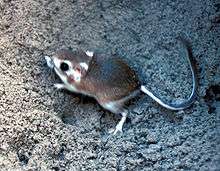Gulf Coast kangaroo rat
The Gulf Coast kangaroo rat (Dipodomys compactus) is a species of rodent in the family Heteromyidae found in Mexico and the state of Texas in the United States.[3] Its appearance and ecology are very similar to those of its putative sister species, Ord's kangaroo rat.[4]
| Gulf Coast kangaroo rat | |
|---|---|
 | |
| Scientific classification | |
| Kingdom: | Animalia |
| Phylum: | Chordata |
| Class: | Mammalia |
| Order: | Rodentia |
| Family: | Heteromyidae |
| Genus: | Dipodomys |
| Species: | D. compactus |
| Binomial name | |
| Dipodomys compactus | |
Description
Adult Gulf Coast kangaroo rats are about 220 mm (8.7 in) long including a tail of about 120 mm (4.7 in). There are two distinct color forms, an ashy gray and a reddish- or yellowish-buff. In both cases the purest color is on the sides and flanks with hairs in the dorsal region having dark tips giving a blackish sheen. The cheeks are white and the ears and upper and lower tail stripes are brown. This species is generally paler in color than other kangaroo rats and can be distinguished from the Ord's kangaroo rat by its shorter, uncrested tail and its shorter, coarser fur.[5]
Distribution
The Gulf Coast kangaroo rat is found in southeastern Texas, southwards from Bexar and Gonzales counties, and in Zapata County, in Mustang Island and Padre Island, just off the coast of Texas, and in the barrier islands off the state of Tamaulipas in Mexico.[1][5]
Ecology
The Gulf Coast kangaroo rat is mainly nocturnal and feeds on seeds which it collects in its cheek pouches and carries back to its burrow.[1] It lives in sparsely-vegetated locations with sandy soils, often among dunes and normally on the down-wind slope of a dune. Plants found growing in the vicinity include sea oats (Uniola paniculata), bluestem grass (Andropogon), saltgrass (Distichlis), fringe-rushes (Fimbristylis), sunflowers (Helianthus) and croton (Croton). In sparse mesquite (Prosopis) savannah in Texas it is associated with wiregrasses (Aristida), hairy grama (Bouteloua hirsuta) and hooded windmill grass (Chloris cucullata), as well as prickly pear (Opuntia).[5]
Status
The population trend of the Gulf Coast kangaroo rat appears to be steady and no particular threats have been identified. In suitable habitat it is quite common and the IUCN has listed it as being of "least concern".[1]
References
- Linzey, A. V. & Hammerson, G. (NatureServe) (2008). "Dipodomys compactus". IUCN Red List of Threatened Species. 2008. Retrieved 7 September 2014.CS1 maint: ref=harv (link)
- True, Frederick W. (1889). "Description of Geomys personatus and Dipodomys compactus, two new species of rodents from Padre Island, Texas". Proceedings of the United States National Museum. 11: 159–160. doi:10.5479/si.00963801.699.159.
- Patton, J.L. (2005). "Family Heteromyidae". In Wilson, D.E.; Reeder, D.M (eds.). Mammal Species of the World: A Taxonomic and Geographic Reference (3rd ed.). Johns Hopkins University Press. p. 845. ISBN 978-0-8018-8221-0. OCLC 62265494.
- Alexander, L. F.; Riddle, B. R. (2005). "Phylogenetics of the New World rodent family Heteromyidae". Journal of Mammalogy. 86 (2): 366–379. doi:10.1644/ber-120.1.
- Baumgardner, George D. (1991). "Dipodomys compactus". Mammalian Species. 369: 1–4. doi:10.2307/3504093. JSTOR 3504093.
